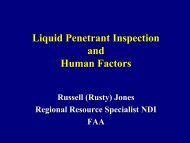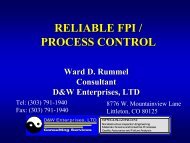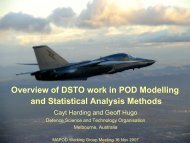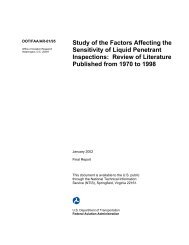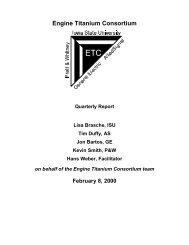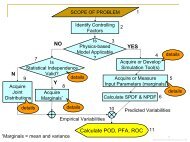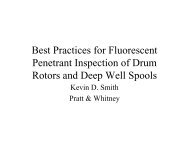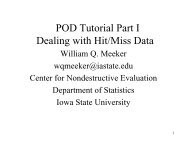Engine Titanium Consortium - Center for Nondestructive Evaluation ...
Engine Titanium Consortium - Center for Nondestructive Evaluation ...
Engine Titanium Consortium - Center for Nondestructive Evaluation ...
You also want an ePaper? Increase the reach of your titles
YUMPU automatically turns print PDFs into web optimized ePapers that Google loves.
system will be at GE, and evaluation of any other systems would be at a location to be agreed upon<br />
by the technical team. Arrangements will be made to accommodate full team participation <strong>for</strong> all of<br />
these evaluations. The laboratory scan results will be reviewed to identify a preferred configuration<br />
<strong>for</strong> factory demonstration and potential implementation. The review will consider inspection<br />
per<strong>for</strong>mance, equipment cost and complexity, operating speed, and other implementation factors.<br />
A hybrid system using fixed focus <strong>for</strong> the outer zones and phased array <strong>for</strong> the center will be<br />
considered as part of this evaluation.<br />
If the final approach agreed to by the technical team <strong>for</strong> factory demonstration includes phased<br />
arrays, additional work will be done to refine the sensor design <strong>for</strong> the selected array approach.<br />
Manufacturer’s engineering specifications <strong>for</strong> the array system design (element geometry,<br />
lens/mirror geometry, etc.) will be input into an array system computational simulation. Theoretical<br />
system per<strong>for</strong>mance will be compared to laboratory measurements of array system response.<br />
Discrepancies between model and experiment will be traced to underlying causes and resolved.<br />
Models will then be used to optimize the design and set up <strong>for</strong> specific test standards targeted <strong>for</strong><br />
study including larger diameter billets.<br />
Factory <strong>Evaluation</strong>: The multizone configuration will be used to per<strong>for</strong>m factory evaluation of five<br />
heats of 10” diameter titanium at a production inspection facility. Cost and detection sensitivity<br />
assessments necessary <strong>for</strong> life management and implementation decisions will be gathered.<br />
Components of cost assessment will include such items as system cost, longevity of equipment,<br />
recurring equipment costs, daily operational/inspection costs, and costs associated with false calls.<br />
<strong>Evaluation</strong> will include cut-ups of any finds. Details of metallography will depend on how many<br />
indications are found, but it is anticipated that all finds will be evaluated to determine cause, and<br />
one will be step-polished to obtain detailed sizing in<strong>for</strong>mation.<br />
Factory Demonstration: An industry-wide demonstration of the multizone system will be scheduled.<br />
OEMs and titanium billet producers will be invited.<br />
Assessment of Large Diameter Billet (>10” dia): Assessment of the sensitivity at larger diameters<br />
will use 13” and 14” diameter standards. Existing 13” standards will be used, and a 14” chord block<br />
standard with near-centerline targets will be designed and built. Initial assessment will be made to<br />
baseline conventional inspection sensitivity either using transducers borrowed from suppliers, or by<br />
requesting suppliers to per<strong>for</strong>m the evaluation in-house. <strong>Evaluation</strong> of zoned fixed-focus capability<br />
will use existing multizone transducers. <strong>Evaluation</strong> will follow a plan to be agreed by consortium<br />
members. If the targeted 4x sensitivity improvement over conventional inspection has been<br />
achieved <strong>for</strong> 13” and 14” diameters, the results will be documented and no further work pursued. If<br />
improvement is still needed, a plan will be <strong>for</strong>mulated following the best approaches (phased array<br />
or improved fixed focus) identified <strong>for</strong> 10” diameter billet. The plan will be presented to the FAA as<br />
continued work is expected to require funding redirection.<br />
Attenuation Compensation Procedures: The current procedures used to measure and compensate<br />
<strong>for</strong> material attenuation will be evaluated and improved. The current procedure <strong>for</strong> the multizone<br />
inspection uses a pre-inspection of four short sections (1” long) of the billet to obtain an average<br />
backwall echo amplitude. This is compared with an average backwall amplitude measured on the<br />
calibration standard and the difference is used to calculate an attenuation compensation factor in<br />
decibels per inch. A transducer focused at the billet center is used to make the measurements.<br />
Quarterly Report – January 1, 2002 –March 31, 2002<br />
print date/time: 6/6/2002 - 8:39 AM – Page 22



